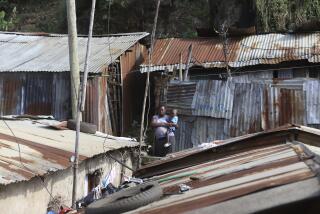Poor South Africans Feather Nests
- Share via
KHAYELITSHA, South Africa — Maphepheni Ncokotwane’s home sounds palatial: two floors, six bedrooms, leather panels on the walls, sweeping views.
But like the hundreds of thousands of poor people in the sprawling Khayelitsha suburb near Cape Town, the 53-year-old merchant lives in a shack. Its relative sophistication is testimony to the flair for innovation shown by some residents.
An estimated 7.3 million South Africans lack proper shelter, a problem dating from the apartheid era, when blacks were confined to the fringes of the economy. They were kicked off prime land--which was reserved for whites--and moved into remote rural homelands or townships on the outskirts of cities and towns.
The bulk of shacks are spartan one-room structures of wood, corrugated iron and plastic, hastily nailed together at minimal expense.
Amid these, however, are some remarkable displays of ingenuity. People turn billboards into walls, old car tires into fences and flattened oil cans into roof shingles.
“People use materials in incredibly inventive ways,” said Jo Noero, director of the University of Cape Town’s architecture school.
The leather panels in Maphepheni’s home are covers torn from old diaries he found in a rubbish dump. They provide good insulation against the southeasters that blast the sandy township streets.
“I don’t want a brick house,” he says, proudly displaying how the second floor of his shack can hold up to 60 people for church meetings.
The structure, which sits beneath a towering electricity pylon, took four months to build. The second floor stands on a large, enclosed wooden platform attached to beams suspended between a series of sturdy poles cemented into the ground.
In other shacks, colorful wallpaper is fashioned from pages torn from old magazines, plastic bags weighted down with rocks are used to waterproof leaky tin roofs and scrap metal is welded together to create artistic divisions between tiny dirt yards.
Noero believes there is a danger in celebrating the efforts of the poor to provide shelter for themselves, saying it detracts from the government’s obligation to build new low-cost homes.
Since the end of all-white rule, the government has built 1.2 million houses, mostly one- or two-room brick structures that many residents complain are too small and poorly constructed.
Despite the program, housing shortages in many cities are worse than ever. A survey by the Institute of Race Relations found rapid urbanization between 1994 and 1999 resulted in about 653,000 new informal dwellings springing up, an increase of 97%.
With about one-third of South Africans unemployed, few people can afford to build their own formal dwellings.
“I want a beautiful and strong place, but I have little money,” said Zukili Ludidi, 22, who runs a barber shop in a flimsy wooden structure on a Khayelitsha sidewalk.
Vicky Ntozini, 32, makes the most of living in a shack. Since 1998, she has run a bed and breakfast at her home, charging foreign tourists 150 rand ($13) a night for an authentic township experience, which includes a meal of sheep’s head and tripe.
The shack’s walls are lined with roughhewn logs--an original touch based on sound financial logic.
“It costs seven rand (60 cents) for a board, but only 2 rand (17 cents) for a log,” Ntozini said.
She and her mechanic husband plan to add a second floor to their four-room shack when they have the time and money.
“It takes a lot of time to renovate, especially when you are living in the place,” she said. “You can have a dream, but if you don’t have money it can be a bit difficult to see it through.”
More to Read
Sign up for Essential California
The most important California stories and recommendations in your inbox every morning.
You may occasionally receive promotional content from the Los Angeles Times.













